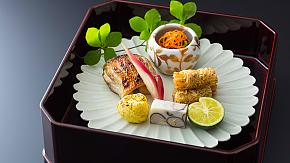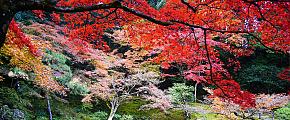Best Time to Visit Japan in 2026
Generally, spring (March to May) and autumn (September to November) are considered the best time to visit Japan, with mild temperatures and pleasant sunny days perfect for a variety of activities.
However, as a year-round destination, each season of Japan offers its own unique beauty and charm. The best time of the year to visit Japan might vary depending on your preferences. From seasonal weather to the best times for various activities, here is your complete guide to planning the perfect trip to Japan at the ideal time for you.
When to Visit Japan Based on Weather
Spring & Autumn - Peak Season
 Autumn Leaves in Japan
Autumn Leaves in Japan
With pleasant weather throughout most of the island and average temperatures around 18°C, spring and autumn are often considered the best times to visit Japan with perfect weather conditions, when you can enjoy a comfortable tour with clear skies and gentle sunshine.
It is a good time for all kinds of outdoor activities, ranging from shrine-hopping beneath sakura blossoms to hiking the Kumano Kodo surrounded by golden leaves.
Summer - Shoulder Season
Compared to other seasons, Japan's summer, marked by the Tsuyu season, has more rainfall, higher humidity, and warmer temperatures averaging between 25 and 30℃. The cooler mountainous areas such as the Japan Alps and Nagano, or the island of Hokkaido in the north, are all good places for your summer getaway. Or just stay in the Honshu region to enjoy the vibrant blossom festivals with fireworks.
For the more adventurous, summer also offers the chance to climb Mt. Fuji. Be aware, however, that this season can bring typhoons to southern cities such as Okinawa in June and July, which can lead to increased rainfall in coastal areas.
Winter - Low Season
 Winter View of Sapporo
Winter View of Sapporo
Japan experiences a chilly winter, with average temperatures ranging from -4 to 10℃. This season is characterized by dry, sunny days and abundant snowfall, making it perfect for grand snow festivals, relaxing hot springs, and thrilling ski experiences, particularly in northern regions like Hokkaido.
Meanwhile, Okinawa in the south remains warm enough for a beach holiday, offering a pleasant winter escape without the chilly breeze.
Month-by-Month Travel Guide to Japan
Explore our Japan travel guides below for insights on the best experiences, weather, and practical tips for each month. From the unique experiences to weather conditions each month offers, you'll find detailed guides on where to visit with practical travel tips.
|
Japan Travel by Month
|
||
| January | February | March |
| April | May | June |
| July | August | September |
| October | November | December |
Best Time to Visit Japan by Interests
For Cherry Blossoms in Japan: March to April
 Cherry Blossoms in Japan
Cherry Blossoms in Japan
Late March to early April is the best time for your cherry blossom tour, when you can capture the pink-clad cities of the Honshu region. Most of the sakura flowers in Tokyo, Kyoto, and Osaka are in full bloom during this peak flowering season, coinciding with vibrant cherry blossom festivals.
Chidorigafuchi Moat and Ueno Park in Tokyo are both popular viewing spots and attract a lot of tourists every spring. Nara Park is also a great choice. After all, who can resist taking a photo of a lovely deer while admiring the cherry blossoms?
It's the perfect time to soak up the spring atmosphere, complete with dancing, singing, and glimpses of traditional art. Meanwhile, be sure to indulge in seasonal spring delicacies, like sakura-flavored wagashi or cherry blossom pancakes, to enhance your spring experience. For a tranquil environment with fewer crowds to enjoy hanami (flower viewing), visit Okinawa, Kawazu, or Atami in January and February for early cherry blossoms. Later, head to Hokkaido to capture the late cherry blossoms, which bloom until May.
For Fall Foliage in Japan: November to December
Ranging from mid-November to early December, it is the best time to visit Japan for seeing the stunning fall colors that paint the cities and streets in bright red and gold. Kyoto, in particular, is one of the most popular destinations to capture the beauty of Japanese-style elegance with ancient temples and shrines dotted with fallen leaves.
Japan will be decorated with fall foliage from late September. If you want to see the red foliage early, Hokkaido in late October is a good choice without worrying about crowds and prices. Noboribetsu Jigokudani, for example, where you can see the mountains covered in red, yellow, and green.
For Hiking in Japan: July to October
The best time to visit Japan for hiking is typically from mid-September to early October, when the leaves start to change into vibrant fall colors, offering stunning views and mild temperatures, especially in the Japanese Alps and higher-altitude mountains.
However, summer (July and August) is also an excellent time for hiking, particularly for climbing Mount Fuji, as it's only accessible during these months. This is the official hiking season for Mount Fuji, with trails and mountain huts open to trekkers. Summer also brings warm temperatures and long days, making it ideal for hiking in other regions, such as the Kumano Kodo Trail and the Japanese Alps. Just keep in mind that summer can be quite humid, especially in lower elevations, so it's crucial to stay hydrated and wear lightweight, breathable clothing.
For Skiing in Japan: January to February
In Japan, the prime skiing season runs from December to early April, with the best snow quality typically between January and February. Hokkaido is known for its heavy, powdery snowfall, offering some of the world's best skiing conditions from late December to February. In Nagano, you'll find a mix of beginner and advanced slopes, with January to March being the ideal time for skiing. Meanwhile, Tohoku is famous for its "snow monsters" and high-altitude slopes, with the best skiing conditions between January and February.
Though we said winter is the low season for Japan, it's the peak season for skiing resorts. So, remember to book your accommodations early, as popular resorts fill up quickly during this time. Besides, it is suggested to rent gear on-site to save your luggage space.
For Festival Experiences in Japan: All Year Round
Japan is home to vibrant festivals (matsuri) year-round. The best time to visit for festivals depends on what kind of experience you're looking for.
Spring is perfect for cherry blossom festivals like Hirosaki Sakura Matsuri and cultural celebrations such as the Takayama Spring Festival. Summer is the peak of lively matsuri, with grand parades and fireworks, including Gion Matsuri in Kyoto, Awa Odori in Tokushima, and the Sumida River Fireworks in Tokyo. Autumn brings historical and harvest festivals, like Jidai Matsuri in Kyoto and Nagasaki Kunchi Festival, set against stunning fall foliage. Winter is all about snow festivals and illuminations, with highlights such as the Sapporo Snow Festival and Otaru Snow Light Path Festival.
Best Time to Visit Japan for Smaller Crowds
Japan experiences fewer crowds during the low season from January to February and the rainy season from June to mid-July. This allows you to enjoy quieter streets and crowd-free attractions, perfect for capturing ideal souvenir photos.
While the weather may not be ideal for outdoor activities, there's still plenty to experience indoors. You can partake in a tea ceremony in a kimono, enjoy a traditional dinner with a geisha, witness a dramatic kabuki performance, or engage in a samurai or ninja experience with a katana (Japanese sword). Plus, there are countless fascinating museums to explore.
For other options with better weather, mid-May after Golden Week, early and mid-September before Silver Week are also good choices for your short break. Embrace the smaller crowds for an immersive Japan adventure!
The Cheapest Time to Visit Japan
January and February are among the cheapest times to visit Japan, making it a low season for most areas except for ski resorts in Hokkaido, Nagano, and the Tohoku region, which are at their peak tourist season.
During this period, flights, accommodations, and attraction tickets tend to be more affordable, although prices may rise slightly during the New Year celebrations in early January.
You can also find relatively lower prices from June to mid-July, despite the higher humidity and temperatures. If your budget allows for a little more flexibility, September and October offer pleasant weather along with reasonable prices, making them highly recommended times to visit.
Plan Your Japan Tour With Odynovo
Ready for your trip to Japan? Whether you want to enjoy the cherry blossom in spring, the fireworks in summer, the fall foliage in autumn, or the snow in winter, Odynovo can provide you with a tailor-made travel plan. Just send to [email protected] to get more information. To make sure you enjoy every moment of your trip, we will carefully plan it based on your interests and budget. Contact us right now to arrange your trip to Japan!
Related Posts You May Like
What Our Clients Say
Explore the latest verified reviews of Odynovo's travel services on Tripadvisor, Google, Trustpilot, Product Review and more trusted platforms.

















